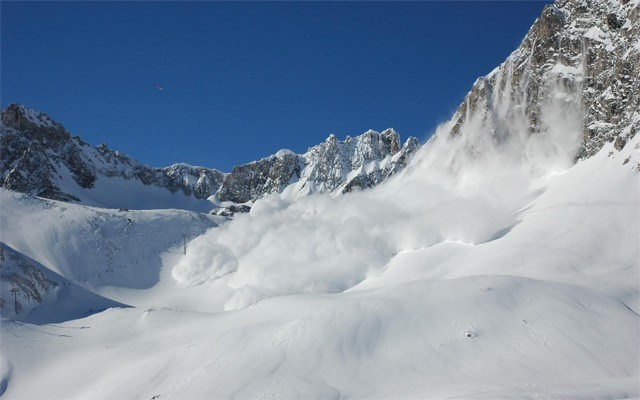Through January, avalanches had killed 21 people in North America this winter, including hikers, climbers and skiers, sledders and snowboarders, both in the sidecountry and farther into the backcountry.
Snowmobilers — including the five killed Jan. 29 near McBride, B.C. — account for 12 of the 21 deaths. Every case is different, but a fatality in late January in Colorado was revealing. It was a day of blue skies at Crested Butte, where six local men decided to hop on their snowmobiles.
Mindful of high avalanche danger, they opted for what seemed safer fun on the lower slopes of Ruby Bowl, about 11 kilometres west of Crested Butte. After building a jump, they used the snowmobiles in yo-yo fashion to ferry skiers and snowboarders up the slope for sliding and jumping.
Located just below treeline, at about 3,350 metres in elevation, the slope seemed tame. Every avalanche book on the planet warns of 30- to 45-degree slopes. This one was just 20 degrees. Above their chosen playground, however, the slopes steepened to between 32 and 42 degrees. That made all the difference.
In early afternoon, after eight laps, two of the men were riding abreast uphill on a snowmobile. Just as they turned the snowmobile, the avalanche from the steep slope above broke. It wasn't a large avalanche, but it buried the snowmobile driver to his shins. His rider was washed downhill 100 metres into a small stand of trees and into a tree well.
Others were quickly on the scene. They had transceivers, metal shovels and probes, the essential avalanche safety equipment. They picked up the signal of their companion and began digging. First a two-metre hole, then another. Nothing — but still the signal. Digging just a metre deeper, they found their companion.
All of this had taken 15 minutes. It was too long. He died later in hospital.
Avalanche transceivers — also called beacons — do in fact save lives. But they provide no guarantees. Consider this: About 25 per cent of all victims die of trauma, not suffocation. In that case, the beacon just helps searchers find the body more easily.
As demonstrated at Crested Butte, time is precious. "Your odds go down immediately with every ticking second, but you see a dramatic rate (of fatalities) after about 15 minutes," says Brian Lazar, of the Colorado Avalanche Information Center.
New technological wrinkles — air bags and Avalungs — have helped on the margins. But again, the best thing is to avoid an avalanche altogether.
Since 1950, Colorado has led the United States in avalanche deaths, with 270 through last year, followed by Alaska (145), Washington (116), Utah (114) and Montana (108).
California comes in down the line with 66 fatalities, despite having just as many high mountains and far more people. However, Colorado has an inland climate, usually featuring a few heavy storms followed by periods of cold. This creates weak, sugary layers of marble-like depth hoar, a recipe for slab avalanches. This winter has been no exception, and the January avalanche near Crested Butte had a fracture line that was a metre deep.
Colorado avalanche forecasters reported that the 10 U.S avalanche deaths in January within a nine-day span was typical in this way: About 70 per cent of fatal avalanche accidents occur within four days of a prior accident, according to a 2012 study. In other words, you can go weeks without an avalanche death — and then wham-bam.
In British Columbia, where 80 per cent of avalanche fatalities in Canada occur, last weekend was a wham-bam. Seventeen snowmobilers were caught in a hellacious avalanche on Mt. Renshaw, part of a snowmobiling paradise around the small town of McBride. Altogether, five men — all from Alberta, ranging in age from 42 to 55 — died. As at Crested Butte, other snowmobilers were quickly on the scene with probes, beacons and shovels. As detailed by the Globe and Mail, they got to one of the victims within five minutes. It was too late.
"Heartbreaking" was the reaction from Mary Clayton, communications director for the Canadian Avalanche Centre. "Clearly, we have a lot of work to do."
Canadian avalanche professionals typically instruct about 8,000 people annually in safety. Just 10 to 15 per cent are snowmobilers. The statistics argue for more rapt attention by sledders. For the decade ending in 2014, avalanches killed 54 snowmobilers in Canada as compared to 49 skiers.
In workshops conducted by the Canadian Avalanche Centre, professionals have shifted their instruction, said Clayton. Instead of dwelling on the physics of snow that determine relative safety of a snowpack, instructors now emphasize terrain in choices. Snow physics — the stuff about layers, temperature gradients, and so forth — is hard to absorb in just a two-day workshop. Making route choices is a simpler story. Stay off slopes of more than 30 degrees and, as in Crested Butte, stay away from the bottom of slopes that steep. Or risk becoming one of these statistics.




